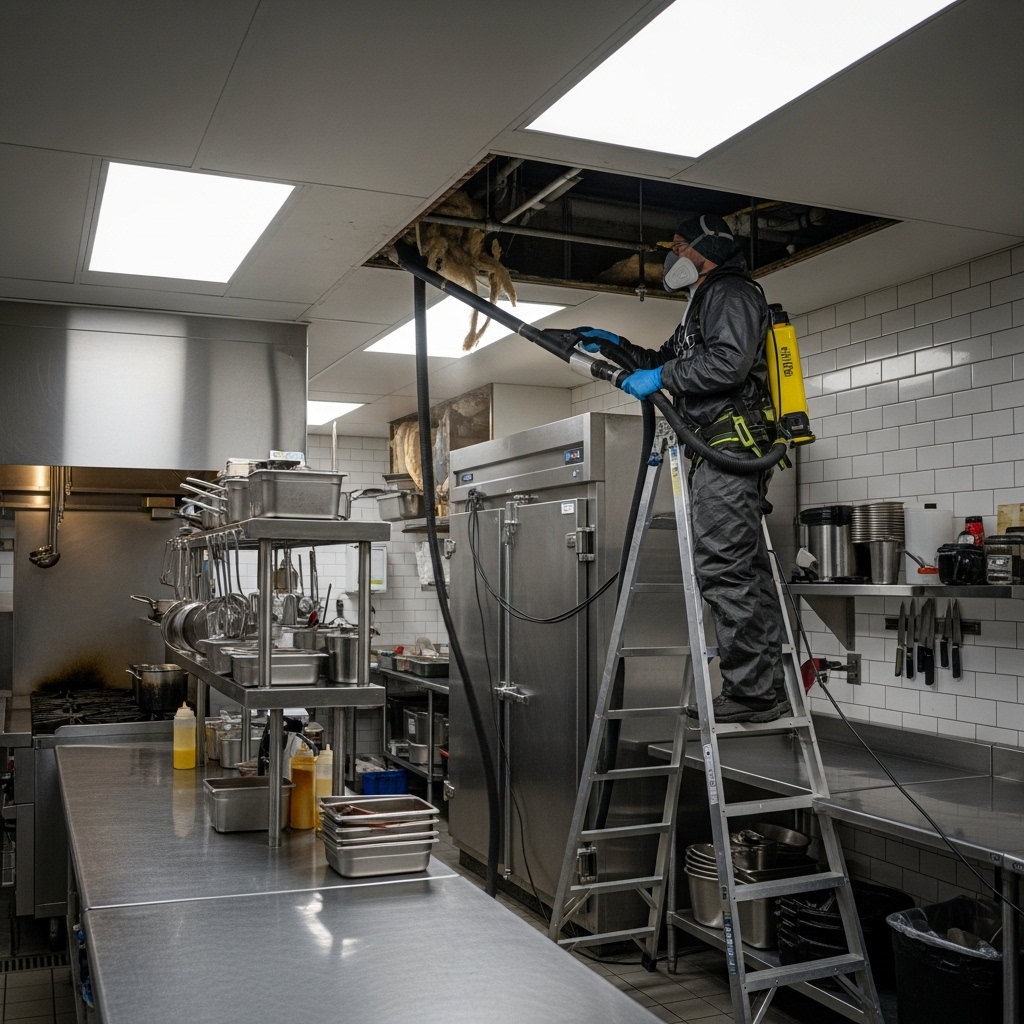The Restaurant Reality in Los Angeles
Running a restaurant in Los Angeles means juggling flavors, staff, suppliers, and guests against a backdrop of constant motion. Deliveries arrive early, service stretches late, and back-of-house spaces work hard. In that nonstop environment, small oversights—an ajar door to the alley, a torn screen on a vent, a neglected corner of a dry storage shelf—can invite rodent activity. The immediate response is often tactical: set traps, adjust waste routines, and tighten staff habits. But after the activity stops, the hidden residue remains. That is where sanitation becomes essential. Comprehensive clean-up restores freshness, protects your brand, and ensures that the next inspection is a confirmation of excellence rather than a list of corrections. Many owners discover that investing in proper rodent sanitation simplifies daily operations by removing persistent odors and worry from the back of their minds.
Los Angeles restaurants range from food trucks and walk-up counters to fine dining rooms with tasting menus. They share one truth: the kitchen is the engine, and engines release heat, moisture, and aroma that attract attention. Pests follow the scent of opportunity, slipping through gaps near floor sinks, utility penetrations, and delivery doors. If activity occurs, residues accumulate in places you rarely see—above the walk-in, behind the line, in ceiling voids over the dish pit. Sanitation is the disciplined process of removing those residues, disinfecting surfaces, and sealing routes so that cleanliness is not a daily battle but a baseline standard.
Where Contamination Hides in Food Service Spaces
The most common hotspots are in the least glamorous corners. The top of the walk-in cooler gathers dust and grease mist that cling to rodent oils and droppings. The void beneath the cookline can harbor debris, and the space behind dry storage racks may catch spills that seep into the wall base. Roof vents above kitchens and prep rooms often have screens that wear out faster than expected, becoming entry points. The challenge is that even after successful control efforts, odors can persist when residues remain in these areas. A thorough sanitation plan targets each zone with containment, HEPA filtration, and disinfectants that are safe for food service environments when used as directed.
Odor is not just a nuisance; it communicates to staff and guests. A faint mustiness in the dining room can undermine confidence in a restaurant that otherwise does everything right. Neutralizing those smells at the source is a strong operational move. It improves working conditions, reduces staff complaints, and helps keep morale high during long shifts.
Staff Training and Culture
Sanitation sticks when it is part of the restaurant’s culture. That starts with training that connects tasks to outcomes—explaining why a door must never be propped during prep, how quickly a produce spill can attract attention, and where to look for early signs of activity. Clear roles help too: who checks the alley gate at close, who verifies the condition of vent screens weekly, who monitors dry storage integrity after large deliveries. When people understand the “why,” the “how” becomes easier. After professional sanitation, reinforce new habits right away to preserve the fresh start.
Communication with vendors is part of culture as well. Ask delivery drivers to stage pallets away from doors and to remove cardboard quickly. If contractors service your HVAC or refrigeration, coordinate so access panels are resecured and penetrations re-sealed the same day. Shared responsibility strengthens results and reduces the chance that a single lapse opens the door to new problems.
Seasonal Pressures in Los Angeles
Weather patterns shape activity across LA. Dry, hot spells drive pests toward water sources—floor sinks, mop closets, and dish areas—while cooler, damp periods can push them to seek warmth in ceiling voids and over equipment that stays warm overnight. Knowing these patterns helps you schedule targeted sanitation and follow-up inspections. In busy neighborhoods with heavy foot traffic and shared dumpsters, the pressure is constant, so regular checks are wise. After major storms or heat waves, a quick review of vents, screens, and door sweeps can prevent weeks of frustration later.
Restaurants near alleys or close to construction zones face unique challenges. Noise and vibration from nearby work can dislodge old materials and open new gaps, while frequent deliveries create short windows where doors are unavoidably open. A responsive sanitation partner will coordinate service hours that match your flow, working early or late to minimize impact.
Sanitation Workflow That Works for Restaurants
In a food service environment, the sanitation plan is a choreography. It starts with isolating the affected areas to protect prep and dining zones, then removing contaminated materials—insulation from ceiling voids, soiled debris from hidden cavities, and any compromised backing boards. HEPA-vacuuming captures fine particulates, followed by disinfectants suitable for the setting, applied with care and adequate dwell time. Deodorization targets wood and porous materials, neutralizing odors rather than masking them. Exclusion closes the loop, sealing penetrations and upgrading screens. When the space is reassembled, staff notices immediately: air feels lighter, ingredients stay fragrant, and the background mustiness lifts.
Documentation at each step benefits everyone. Photos of treated areas and lists of sealed entries help managers coach staff and show inspectors the depth of work performed. If you operate multiple locations, this record becomes a template for standards across the group, making training and accountability easier.
Protecting Your Brand and Guest Experience
Your brand is built in the details guests never see. A dining room that smells neutral and a kitchen that feels calm are the result of systems behind the scenes. After sanitation, chefs often remark that they can “smell the food again,” not the environment. Servers notice that side stations feel fresher. Managers see customer reviews focusing solely on service and cuisine, not on a whiff of something odd near the restrooms. These small wins add up to a stronger reputation and returning guests.
Another benefit is operational focus. When staff is not distracted by nagging odors or repeat issues, they can dedicate energy to hospitality. That focus shows up in faster service, better teamwork, and fewer surprises during rushes. Sanitation, in other words, strengthens the foundation upon which great service rests.
Mid-Project Check-Ins Build Confidence
Because restaurants run on tight schedules, quick updates during sanitation matter. A photo confirming that the void above the walk-in is clean, a message that vent screens were upgraded, or a note that the dish area ceiling has been sealed—these touchpoints keep managers informed and reduce anxiety. They also make it easy to share progress with owners or regional directors. If questions arise about methods or materials, pointing to professional rodent sanitation standards helps align expectations across the team.
Frequently Asked Questions
Can sanitation be performed without interrupting service? Yes. Work can be scheduled outside service hours or in phases that protect prep areas. With good containment, restaurants can maintain operations while major areas are treated after closing or before opening.
Are the products used safe for kitchens? Professional teams use disinfectants and methods appropriate for food service environments when applied correctly. Surfaces that contact food are handled with care and according to guidelines.
How often should restaurants schedule follow-ups? After a comprehensive sanitation, periodic checks aligned with your maintenance calendar keep everything tight. Seasonal reviews after heat waves or heavy rains are especially helpful.
Will sanitation affect my health inspection? Proper sanitation supports a clean environment and can reduce risk factors that lead to point deductions. Documentation of work performed is useful during discussions with inspectors.
What can staff do daily to maintain results? Close doors promptly, keep storage areas organized, remove cardboard quickly, and report any new gaps or unusual odors right away so small issues do not grow.
Give Your Team the Fresh Start It Deserves
If your kitchen has battled persistent odors, if the ceiling void above the dish area makes you uneasy, or if staff keeps reporting the same corner as a trouble spot, it is time to reset. A focused sanitation plan will remove residues, neutralize odors, and seal pathways so your team can concentrate on hospitality. Partner with specialists who respect your schedule and understand food service priorities, and take the first step with professional rodent sanitation. Your Los Angeles restaurant can breathe easier—so can your staff and your guests.

